2016秋七年级英语上册Unit3《BodyPartsandFeelings》测试卷3(无答案)(新版)冀教版
【冀教版】七年级上册:Unit 3《Body Parts and Feelings》全单元教案【精校版】
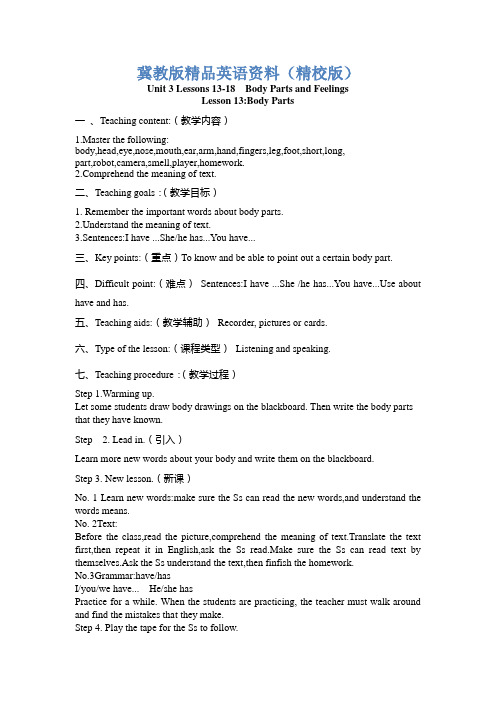
冀教版精品英语资料(精校版)Unit 3 Lessons 13-18 Body Parts and FeelingsLesson 13:Body Parts一、Teaching content:(教学内容)1.Master the following:body,head,eye,nose,mouth,ear,arm,hand,fingers,leg,foot,short,long,part,robot,camera,smell,player,homework.prehend the meaning of text.二、Teaching goals:(教学目标)1. Remember the important words about body parts.2.Understand the meaning of text.3.Sentences:I have ...She/he has...You have...三、Key points:(重点)To know and be able to point out a certain body part.四、Difficult point:(难点)Sentences:I have ...She /he has...You e about have and has.五、Teaching aids:(教学辅助)Recorder, pictures or cards.六、Type of the lesson:(课程类型)Listening and speaking.七、Teaching procedure:(教学过程)Step 1.Warming up.Let some students draw body drawings on the blackboard. Then write the body parts that they have known.Step 2. Lead in.(引入)Learn more new words about your body and write them on the blackboard.Step 3. New lesson.(新课)No. 1 Learn new words:make sure the Ss can read the new words,and understand the words means.No. 2Text:Before the class,read the picture,comprehend the meaning of text.Translate the text first,then repeat it in English,ask the Ss read.Make sure the Ss can read text by themselves.Ask the Ss understand the text,then finfish the homework.No.3Grammar:have/hasI/you/we have... He/she hasPractice for a while. When the students are practicing, the teacher must walk around and find the mistakes that they make.Step 4. Play the tape for the Ss to follow.Step 5.Summary. (小结)Sum up the body parts,distinction have and has how to use it.Step 6. Homework.(作业)Do your excise book.Step 7.Blackboard-writing:(板书)八.Teaching reflection:(教后反思)Lesson 14:Colors and Feelings一、Teaching content:(教学内容)1.To master these words:sad, sick, scared, angry. To understand the following:question.smile,mean.2. some useful patterns:How can you feel a color? Don't be scared!二、Teaching goals:(教学目标)1.to learn how to express the feelings .2.to learn more about the colors.3.to use what was learned in the daily life三、Key points:(重点)The words about feelings: sad, sick, scared, angry.四、Difficult point:(难点)What colors stand for what feelings.五、Teaching aids:(教学辅助)Recorder, pictures or cards.六、Type of the lesson:(课程类型)Listening and speaking.七、Teaching procedure:(教学过程)Step 1.Warming up.Review the words about colors.Step 2. Lead in.(引入)Ask the students questions in the life. You give a student a present and ask his feeling now. Then lead the words:happy, sad, sick, scared, angry.Step 3. New lesson.(新课)No. 1 I feel blue.Li Ming:Hi,Jenny!I am listening to an English song.In the song,the singer says "I feel blue".How can you feel a color?Jenny:That's a good questions.In English,we use many colors for our feelings.Blue can mean "sad".Green can mean "sick".Yellow can mean "scared".And red can mean "angry".Li Ming:Wow!Thank you,Jenny.In China,red is a happy color.No. 2 Sentences:Don't feel bad.Don't be scared.Don't see red.Don't feel sick.Step 4. Play the tape for the Ss to follow.Step 5.Summary. (小结)Sum up the words about feelings,and what colors for what feelings.Step 6. Homework.(作业)Finish the activity book.Step 7.Blackboard-writing:(板书)The words about feelings.八.Teaching reflection:(教后反思)Lesson 15:Tall or Short一、Teaching content:(教学内容)1.master these new words: tall,short.2.to understand these words: Meter, stand, on3. the in-structures : How tall are you? I’m 1.6 meters tall.二、Teaching goals:(教学目标)1.to be able to ask about one’s hight.2.ask the students to do active practice3.Sentences:How tall are you? How tall is she/he?三、Key points:(重点)1.how to say one’s height in English.2.to be able to read the text in the correct tones with the perfect pronunciation.四、Difficult point:(难点)How to read out “3.1 meters , 1.6 meters”. (plural forms of nouns)五、Teaching aids:(教学辅助)Recorder, pictures or cards.六、Type of the lesson:(课程类型)Listening and speaking.七、Teaching procedure:(教学过程)Step 1.Warming up.Learn new word:tall,short,meter,stand ,against,tail,flat,upon,ground.Step 2. Lead in.(引入)Introduce the text first in Chinese,then ask the Ss read the pictures,answer the questions.Step 3. New lesson.(新课)No. 1 Presentationa ruler or some other things while can be used to measure the length, the height, and so on.No. 2 Practice telling one heightAsk the students :1. How tall are you?2. How tall is she/he?3. How tall is your teacher?4. How tall is your friend?Talk about the partner about the subject. Then ask volunteers to come to the front to act the dialogue out.Step 4. Play the tape for the Ss to follow.Step 5.Summary. (小结)Practice the dialogue . Let some students act it out.Step 6. Homework.(作业)Finish the activity book.Step 7.Blackboard-writing:(板书)The important words.八.Teaching reflection:(教后反思)Lesson 16:Happy or Sad一、Teaching content:(教学内容)1.To master these words:happy, sad.To understand the following:very, tired,enough.2. some useful patterns:How do you feel? I feel happy! I’m NOT fine, thanks. Are you tired? No, I’m not. I just feel sad.二、Teaching goals:(教学目标)1.to learn how to express the feeling of sad and happy.2.to learn more about the feelings.3.to use what was learned in the daily life.三、Key points:(重点)How do you feel? I feel happy! I’m NOT fine, thanks. Are you tired? No, I’m not. I just feel sad.四、Difficult point:(难点)Practice the dialogue.五、Teaching aids:(教学辅助)Recorder, pictures or cards.六、Type of the lesson:(课程类型)Listening and speaking.七、Teaching procedure:(教学过程)Step 1.Warming up.Ask the students questions in the life. You give a student a present and ask his feeling now. Then lead the words: happy, sad.Step 2. Lead in.(引入)Before the class,make the Ss understand the followingquestions:1.How does Jenny feel?2.Is Danny hurt?3.Is Danny tired?Step 3. New lesson.(新课)No. 1 Give the presents that you prepared to the s tudents that do well. Then ask “How do you feel?” Explain it in Chinese when it is necessary. Help them answer “I’m happy.” Then take their presents away and ask “How do you feel now?” Help them answer “I’m sad”No. 2Begin “happy, sad” game in pairs, using the presents that we prepared before the class. The best one will get a present.Let’s sing a song together. Listen to the tape and sing happily after it. Encourage students to sing loudly because what we need is a happy feeling. The students can stand up and do according to the text.Step 4. Play the tape for the Ss to follow.Step 5.Summary. (小结)Sum up sentences:How do you feel?Step 6. Homework.(作业)Finish the activity book.Step 7.Blackboard-writing:(板书)八.Teaching reflection:(教后反思)Lesson 17:Seeing a Doctor一、Teaching content:(教学内容)Master these new words and expressions: How do you feel? hurt,stomachache,headache,medicine,have a good rest,see a doctor,have a cold,what's the matter?二、Teaching goals:(教学目标)1.Encourage students to express the uncomfortable feeling.2.Practice the sentences go on:How do you feel? What’s the matter?3.Understand the meaning of text and practice the dialogue.三、Key points:(重点)Help students grasp the expressions to ask and answer the uncomfortable feeling. 四、Difficult point:(难点)Learn the key sentence: What’s the matter? ___ hurt(s). I have a -ache.五、Teaching aids:(教学辅助)Recorder, pictures or cards.六、Type of the lesson:(课程类型)Listening and speaking.七、Teaching procedure:(教学过程)Step 1.Warming up.Let some students draw body drawings on the blackboard. Then write the body parts that they have known.Step 2. Lead in.(引入)Learn more new words about your body and write them on the blackboard.Step 3. New lesson.(新课)No. 1 PresentationListen and repeat the new words. Because some words are hard, we listen and repeat for several times until we can read the words correctly.Point to parts of your body as you and the class say the words.No. 2 Dialogue:1 Are you OK?Jenny:How do you feel,Jim? Are you OK?Jim:See my arm?It hurts.Jenny:It looks bad!Let's go and see a doctor.2.You have a cold.Dr.Green:Hi,Danny.What's the matter?Danny:I feel sick.I have a headache.Dr.Green:Do you feel cold?Danny:Yes!I feel very cold.Dr.Green:Well,let me see...You have a cold.Take this medicine.Stay home and have a good rest.Danny:OK.Thank you ,Doctor Green.Step 4. Play the tape for the Ss to follow.Step 5.Summary. (小结)Sum up the phrases:How do you feel? have a good rest,see a doctor,have a cold,what's the matter?You'd better...Step 6. Homework.(作业)Finish the activity book.Step 7.Blackboard-writing:(板书)The useful phrase.八.Teaching reflection:(教后反思)Lesson 18:We All Look Different一、Teaching content:(教学内容)1.master these new words:hair, has.2.learn and understand these words:different,blond.eful instructions : What does he/she look like? She /he has long/short hair. I have short hair.二、Teaching goals:(教学目标)1.learn to describe the looking of oneself and other students.2.to be able to read the text fluently.3.to write a short passage in English, describe oneself or other people.三、Key points:(重点)How to describe one’s hair, including the length and the color.四、Difficult point:(难点)The verb should be in a special form, such as have and has.五、Teaching aids:(教学辅助)Recorder, pictures or cards.六、Type of the lesson:(课程类型)Listening and speaking.七、Teaching procedure:(教学过程)Step 1.Warming up.Review: Express the feelings of yourself. You can say like this: Are you OK? How do you feel? Let some students answer and ask questions like this.Step 2. Lead in.(引入)Introduce the text in Chinese first.Learn to describe the looking of oneself and other students.Step 3. New lesson.(新课)No. 1 What does he/she look like?(describe people)She is beautiful.He is good-looking.He looks cool!She looks cute!No. 2 We all look different.(have/has)She has short blond hair.He has three black hair.I have short black hair.Step 4. Play the tape for the Ss to follow.Step 5.Summary. (小结)Sentences: What does he/she look like? She /he has long/short hair. I have short hair.Step 6. Homework.(作业)Come to the activity book.Step 7.Blackboard-writing:(板书)The master words.八.Teaching reflection:(教后反思)Unit Review一、Teaching content:(教学内容)1.Words and phrases .2.Key sentences .二、Teaching goals:(教学目标)1. Enable students to use the words and the expressions learned freely.2.Help students grasp the expressions in their daily life.三、Key points:(重点)The words and the expressions in this unit.四、Difficult point:(难点)How to use “have” and “has”.五、Teaching aids:(教学辅助)Recorder, pictures or cards.六、Type of the lesson:(课程类型)Review.七、Teaching procedure:(教学过程)Step 1.Warming up.Review words and expressions in this unit .Step 2. Task:No. 1 Building your vocabulary.Finish the excise on page 46 for remembering more word.No. 2 Grammar in use.(have/has)Practice:Fill in the blanks with have/has.1.May I a pencil,Jenny?2.Danny many yellow shirts.3.You a cold.You'd better go and see a doctor.4.She feels sick.She a stomachache.Step 3. Play the tape for the Ss to follow.Then finish the homework.Step 4.Summary. (小结)Sum up the phrases:play with,listen to,wave one's hand,see red,How tall is she/he? How tall are you? a bit,How do you feel?What's wrong?What's the matter?See a doctor.Are you OK? I have a headache.You'd better ... Have a cold.stay home.have a rest. What does he/she look like? Look different.look cool/cute/funny.Step 5. Homework.(作业)Finish the excises book.Step 6.Blackboard-writing:(板书)Grammar.八.Teaching reflection:(教后反思)。
七年级英语上册Unit3BodyPartsandFeelingsLesson13BodyParts同

Lesson 13Body Parts Ⅰ.单项选择。
1.My ________ are very small.A.foot B.foots C.feet D.feets2.—What's this?—It's ________ camera.A.a B.an C.two D./3.I can see ________ my eyes.A.at B.with C.to D.for4.You must do your ________ first.A.homework B.homeworksC.a homework D.the homework5.We have one ________ and one ________.A.heads;nose B.head;nosesC.heads;noses D.head;nose6.The girl's ________ is big,and her ________ is big,too.A.body;eyes B.head;hairC.head;face D.nose;earsⅡ.连词成句。
7.a,football,I'm,player,good___________________________________________________. 8.mother,me,noodles,my,makes,for___________________________________________________. 9.don't,ears,I,have,I,hear,but,can,you ___________________________________________________. 10.you,my,for,can,me,do,homework__________________________________________________? Ⅲ.根据图片及首字母提示完成短文。
冀教版英语七年级上册Unit 3 Body Parts and Feelings 重难点知识归纳总结

Unit 3 Body Parts and Feelings【重点单词】1.part /pɑːt/ n. 部分2.feeling /ˈfiːlɪŋ/ n. 感觉;情感(常用作复数)3.robot /ˈrəʊbɒt/ n. 机器人4.camera /ˈkæmrə/ n. 照相机5.smell /smel/ v. 嗅;闻起来6.finger /ˈfɪŋɡə(r)/ n. 手指(大拇指除外)7.player /ˈpleɪə(r)/ n. 比赛者;选手8.homework /ˈhəʊmwɜːk/ n. 家庭作业9.singer /ˈsɪŋə(r)/ n. 歌手10.question /ˈkwestʃən/ n. 问题11.sick /sɪk/ adj. 病的;生病的12.scared /skeəd/ adj. 恐惧的13.smile /smaɪl/ v. 微笑14.wave /weɪv/ v. & n. 挥手;招手15.mean /miːn/ v. 意思是adj. 刻薄的16.metre /'mi:tə(r)/ n. 米17.bit /bɪt/ n. 小量;少量18.against /əˈɡenst; əˈɡeɪnst/ prep. 倚着,靠着;反对,违反19.tail /teɪl/ n. 尾部;尾巴20.flat /flæt/ adv. 水平地21.upon /əˈpɒn/ prep. 在……上面22.ground /ɡraʊnd/ n. 地面23.hurt /hɜːt/ adj. 痛的;受伤的v. 伤害;疼痛24.donut /ˈdəʊnʌt/ n. 面包圈25.enough /ɪˈnʌf/ adj.& adv. 足够的(地)ugh /lɑːf/ v. 笑27.stomachache /'stʌməkeɪk/ n. 肚子痛;胃痛28.better /ˈbetə(r)/ adj.& adv. (good/well的比较级)更好的(地)29.matter /ˈmætə(r)/ n. 问题30.headache /ˈhedeɪk/ n. 头痛31.medicine /ˈmedsn/ n. 药32.stay /steɪ/ v. 停留;留下;待一段时间33.rest /rest/ n.&v. 休息34.different /ˈdɪfrənt/ adj. 不同的35.cute /kjuːt/ adj. 逗人喜爱的;漂亮的36.twelve /twelv/ num. 十二37.blond /blɒnd/ adj.&n. 金色(的);浅黄色(的)38.thirteen /ˌθɜːˈtiːn/ num. 十三39.almost /ˈɔːlməʊst/ adv. 几乎;差不多40.funny /ˈfʌni/ adj. 有趣的;可笑的41.glass /ɡlɑːs/ n. 眼镜(glasses);玻璃,玻璃杯【重点短语】1.play with 和……一起玩2.listen to 听3.wave one’s hand 挥手4.a bit 有一点5.stand against/upon 靠着……站6.see a doctor 看医生7.You’d better... 你最好……8.What’s wrong? 怎么了?9.feel sick 感到不舒服10.have a headache 头痛11.have a cold 感冒12.take medicine 吃药13.stay home 待在家里14.have a rest 休息【重点句型】1.Do you want to play with me? 你想和我一起玩吗?2.Can you do my homework for me, Robin? 你能帮我做作业吗,罗宾?3.Sorry, I can’t do your homework, but I can make noodles for you. 对不起,我不能做你的家庭作业,但是我可以给你做面条。
七年级英语上册Unit3BodyPartsandFeelings文化背景资料(加拿大人的手势习惯)(
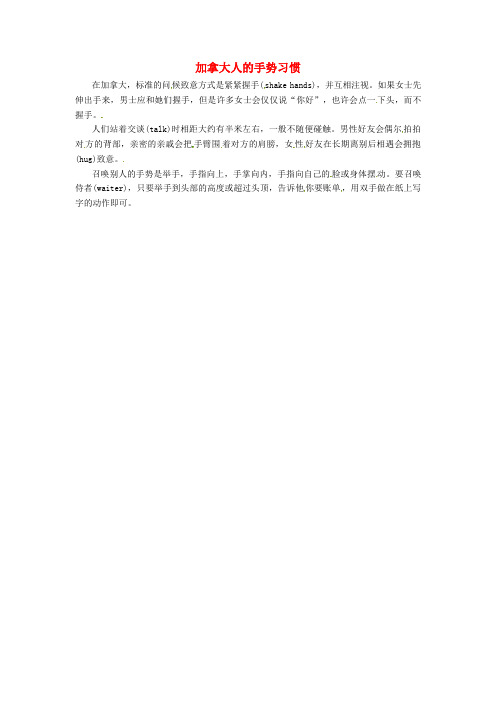
加拿大人的手势习惯
在加拿大,标准的问候致意方式是紧紧握手(shake hands),并互相注视。
如果女士先伸出手来,男士应和她们握手,但是许多女士会仅仅说“你好”,也许会点一下头,而不握手。
人们站着交谈(talk)时相距大约有半米左右,一般不随便碰触。
男性好友会偶尔拍拍对方的背部,亲密的亲戚会把手臂围着对方的肩膀,女性好友在长期离别后相遇会拥抱(hug)致意。
召唤别人的手势是举手,手指向上,手掌向内,手指向自己的脸或身体摆动。
要召唤侍者(waiter),只要举手到头部的高度或超过头顶,告诉他你要账单,用双手做在纸上写字的动作即可。
冀教版七上:unit 3《body parts and feelings》(lessons 13-15)课文重点整理
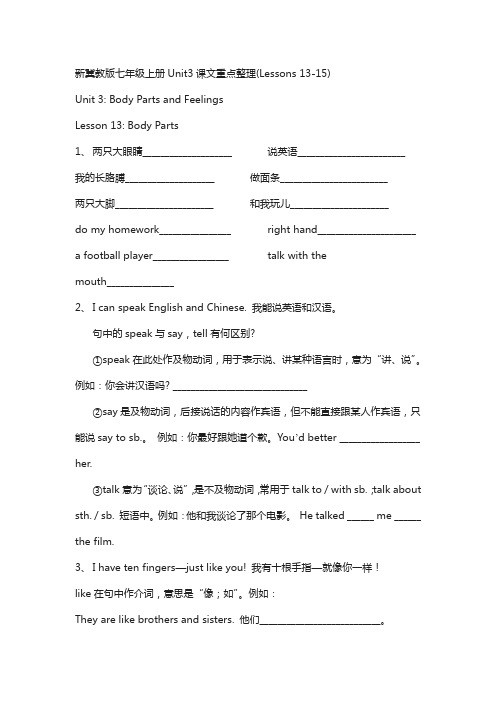
新冀教版七年级上册Unit3课文重点整理(Lessons 13-15)Unit 3: Body Parts and FeelingsLesson 13: Body Parts1、两只大眼睛____________________ 说英语________________________我的长胳膊____________________ 做面条________________________ 两只大脚______________________ 和我玩儿______________________ do my homework________________ righthand______________________a football player_________________ talk with themouth_______________2、 I can speak English and Chinese. 我能说英语和汉语。
句中的speak与say,tell有何区别?①speak在此处作及物动词,用于表示说、讲某种语言时,意为“讲、说”。
例如:你会讲汉语吗? ______________________________②say是及物动词,后接说话的内容作宾语,但不能直接跟某人作宾语,只能说say to sb.。
例如:你最好跟她道个歉。
You’d better __________________ her.③talk意为“谈论、说”,是不及物动词,常用于talk to / with sb.;talk about sth. / sb. 短语中。
例如:他和我谈论了那个电影。
He talked ______ me ______ the film.3、 I have ten fingers—just like you! 我有十根手指—就像你一样!like在句中作介词,意思是“像;如”。
例如:They are like brothers and sisters. 他们___________________________。
冀教版七年级英语上册《nit 3 Body Parts and Feelings Unit Review》优质课教案_3
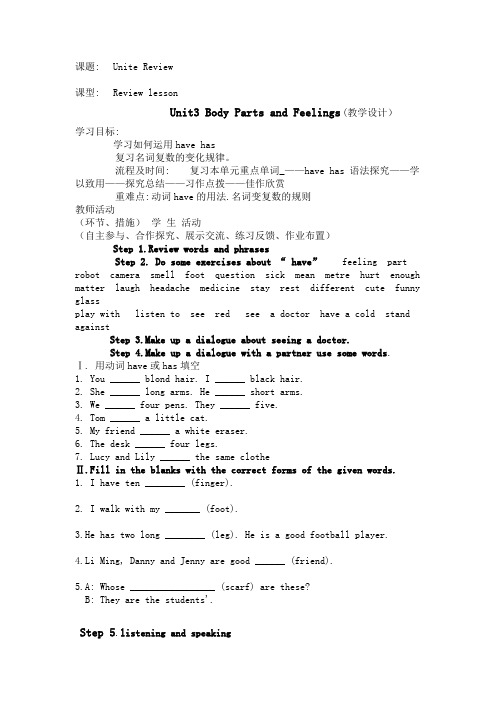
课题: Unite Review课型: Review lessonUnit3 Body Parts and Feelings(教学设计)学习目标:学习如何运用have has复习名词复数的变化规律。
流程及时间: 复习本单元重点单词_——have has 语法探究——学以致用——探究总结——习作点拨——佳作欣赏重难点: 动词have的用法.名词变复数的规则教师活动(环节、措施)学生活动(自主参与、合作探究、展示交流、练习反馈、作业布置)Step 1.Review words and phrasesStep 2. Do some exercises about “ have”feeling part robot camera smell foot question sick mean metre hurt enough matter laugh headache medicine stay rest different cute funny glassplay with listen to see red see a doctor have a cold stand againstStep 3.Make up a dialogue about seeing a doctor.Step 4.Make up a dialogue with a partner use some words.Ⅰ. 用动词have或has填空1. You ______ blond hair. I ______ black hair.2. She ______ long arms. He ______ short arms.3. We ______ four pens. They ______ five.4. Tom ______ a little cat.5. My friend ______ a white eraser.6. The desk ______ four legs.7. Lucy and Lily ______ the same clotheⅡ.Fill in the blanks with the correct forms of the given words.1. I have ten ________ (finger).2. I walk with my _______ (foot).3.He has two long ________ (leg). He is a good football player.4.Li Ming, Danny and Jenny are good ______ (friend).5.A: Whose _________________ (scarf) are these?B: They are the students'.Step 5.listening and speaking/e/ red help smell twelve/æ/ can sad have stand/u:/ blue cool noodle/u/ good look footballStep 6 习作点拨本单元以“人物描写”为话题,围绕这一话题描述人的长相,谈论人的身体结构。
七年级英语上册unit3bodypartsandfeelinglesson13bodyparts

Image
12/8/2021
A. is B. has C. have D. are 5 . I often play______C__my little sister . A. at B. for
C. with
第十九页,共二十一页。
作业布置
1. Draw a picture of yourself. Mark the parts of your body. And write down
七年级上册
Unit 3 Body Parts and Feeling
Lesson13 Body Parts
第一页,共二十一页。
学习目标
1)学习(xuéxí)的任务和目标 1) To learn the new words and phrases:part,feeling,robot,camera,smell,finger, player,homework,play with,talk with sb=talk to sb=have a talk with sb,hear from sb,turn around,have fun,put in,do homework,like to,take out. 2) The important sentence structures:
I have two big eyes. b.And I can talk with my mouth.
冀教版初中英语七年级上册Unit 3 Body Parts and Feelings (教案)
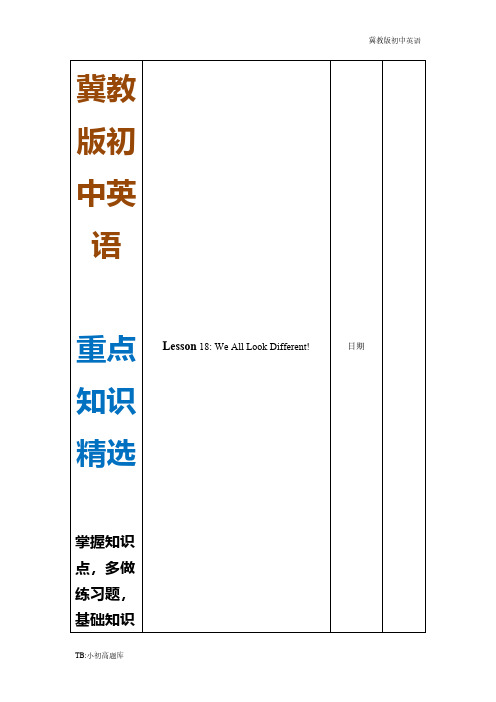
课后反思与重建
TB:小初高题库
冀教版初中英语
相信自己,就能走向成功的第一步 教师不光要传授知识,还要告诉学生学会生活。数学思维
可以让他们更理性地看待人生
TB:小初高题库
了解如何描述一个人的外貌特征。
TB:小初高题库
冀教版初中英语
重点难点
会准确使用 have, has 及多个形容词的排列顺序。
教学时数
2
教学方法 自主学习及合作学习
教学准备
Teaching Preparation: audiotape, flashcards,
教学过程: Step1.Greet each other before the class. Step2 知识超市 1. What does he/she look like?他/她看起来怎么样?
Step7. Homework
1. Finish the exercises on Page45.
2. Finish the exercises in. Unit Review.
板书设计
1. good-looking
2. short blond hair 3. big and tall 4. a pretty girl 5. wear glasses 6 look different
Step3. 合作探究 1.请听课文的录音两遍,根据课文内容填空。
Jenny is from Canada. She is twelve years old. She has short blond hair. Her eyes are blue. She is a pretty girl. Danny is from Canada. He is thirteen years old. He has three black hairs. He is big and tall. He looks funny. I have short black hair. I wear glasses. We all look different. Step4. 请仔细阅读课文,独立完成课本 P45 上第 2 部分的练习题。 Step 5 想一想 1. look different 的反义词是什么,其中 look 是什么词? 2. almost 和 nearly 都是“几乎”的意思,他们的用法一样吗 3. all 这个词在句子放在什么位置?
Unit3 Body parts and feelings

Unit3一、词组和句型。
Lesson131. 身体部位___________________________________2. 用鼻子闻;用嘴巴说__________________________3. 用耳朵听;用眼睛看__________________________4. 想要做某事_________________________________5. 喜欢做某事_________________________________6. 就像_______________________________________7. 玩得开心___________________________________8. 做作业_____________________________________9. 为某人制作某物_____________________________10. 把…放到…里______________________________11. 把…拿出__________________________________12. 转圈______________________________________ Lesson141. 听一首英语歌_______________________________2. 一个好问题_________________________________3. 用许多颜色代表我们的感觉___________________4. …的意思是什么?____________________________5. 感到难过___________________________________6. 火冒三丈___________________________________7. 挥手_______________________________________8. 和某人玩___________________________________9. make的用法:________________________________ _______________________________________________ 10. 观看恐怖电影______________________________ Lesson151. 一个高个子的男人___________________________2. 1.6米高____________________________________3. 有点矮_____________________________________4. 你有多高?_________________________________5. 靠墙站着___________________________________6. 直直的站在_________________________________7. 与…相反的_________________________________8. a bit 和a little的用法:___________________________________________ ___________________________________________ ___________________________________________ ___________________________________________ Lesson161. 感到高兴___________________________________2. 怎么了?___________________________________3. 一天一个面包圈_____________________________4. enough的用法:_______________________________________________ _______________________________________________ _______________________________________________ 5. 别难过____________________________________6. 想要某人做某事_____________________________ Lesson171. 你感觉怎么样?_____________________________2. 感觉病了___________________________________3. 肚子疼_____________________________________4. 最好做、不做某事____________________________5. 让某人做某事_______________________________6. 感冒;头疼___________________________________7. 吃药;待在家里;好好休息______________________________________________ 8. 你还好吗?________________________________ Lesson181. 看起来不同_________________________________2. 某人长什么样?____________________________回答:______________________________________ ______________________________________ 3. 他、她看起来很酷、很可爱、很滑稽、不同______________________________________________ 4. look like 和be like的用法:_______________________________________________ _______________________________________________5. 金黄色的短发_______________________________6. 三根黑头发_________________________________7. 戴着眼镜___________________________________8. 喜欢穿裙子_________________________________ Review1. 站在…前面_________________________________2. 告诉某人去做某事___________________________3. 一张你自己的照片___________________________4. 给某人照相_________________________________5. 名词复数的构成:●________________________________________ ●__________________________________________________________________________________ ●__________________________________________________________________________________ ●__________________________________________________________________________________ ●__________________________________________________________________________________ ●__________________________________________________________________________________ ●__________________________________________________________________________________ ●____________________________________________________________________________________________________________________________________________________________________二、用所给词的适当形式填空。
七年级英语上册_Unit_3_Body_Parts_and_Feelings_Lesson_13_Body_Parts 课件

单选
D 1.We can ____with our feet. A. see B. talk C. listen D. walk B 2.Most people write with their ____hand. A. left B. right C. big D. small B like it very much. 3.My pencil box is old, _____I A. and B. but C. or D. so 4.That boy’s _____is very long C C. hair D. feet A. heads B. arms
Listen and fill in the blanks. eyes •I have two big ______. I can ______ see with them. •I have one nose and one mouth ______. ears but I can •I don’t have ______ ______ hear you. •I can make noodles with my long arms and small _____ hands. •I have two long legs and two big feet. I’m a good footballplayer ______.
1
Listen and answer the questions.
•Who is Robin? Robin is a robot. •Can Robin speak English and Chinese?
Yes. does Danny want Robin •What to do? Danny wants Robin to do his homework for him.
【冀教版】七年级上册:Unit 3《Body Parts and Feelings》(Lessons 13-15)课文重点整理(精修版)
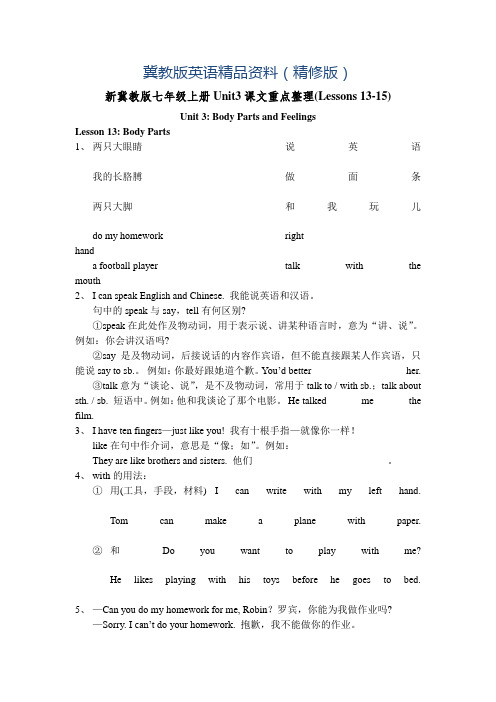
冀教版英语精品资料(精修版)新冀教版七年级上册Unit3课文重点整理(Lessons 13-15)Unit 3: Body Parts and FeelingsLesson 13: Body Parts1、两只大眼睛____________________ 说英语________________________我的长胳膊____________________ 做面条________________________两只大脚______________________ 和我玩儿______________________do my homework________________ righthand______________________a football player_________________ talk with the mouth_______________2、 I can speak English and Chinese. 我能说英语和汉语。
句中的speak与say,tell有何区别?①speak在此处作及物动词,用于表示说、讲某种语言时,意为“讲、说”。
例如:你会讲汉语吗? ______________________________②say是及物动词,后接说话的内容作宾语,但不能直接跟某人作宾语,只能说say to sb.。
例如:你最好跟她道个歉。
You’d better __________________ her.③talk意为“谈论、说”,是不及物动词,常用于talk to / with sb.;talk about sth. / sb. 短语中。
例如:他和我谈论了那个电影。
He talked ______ me ______ the film.3、 I have ten fingers—just like you! 我有十根手指—就像你一样!like在句中作介词,意思是“像;如”。
七年级英语上册Unit3BodyPartsandFeelings词句精讲精练新冀教1107140
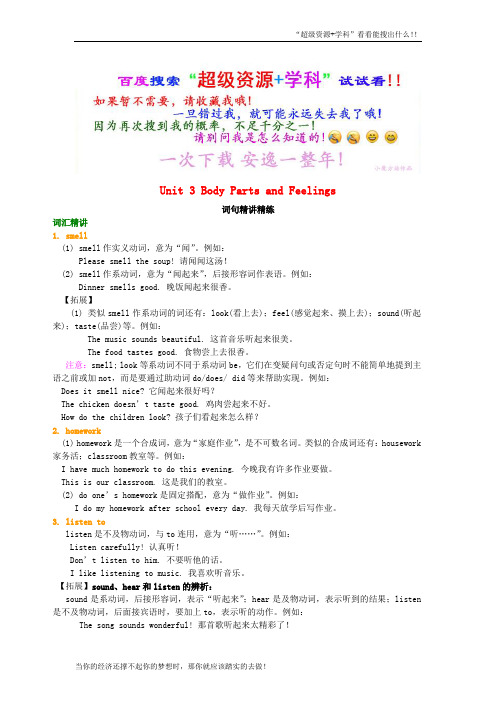
Unit 3 Body Parts and Feelings词句精讲精练词汇精讲1. smell(1) smell作实义动词,意为“闻”。
例如:Please smell the soup! 请闻闻这汤!(2) smell作系动词,意为“闻起来”,后接形容词作表语。
例如:Dinner smells good. 晚饭闻起来很香。
【拓展】(1) 类似smell作系动词的词还有:look(看上去);feel(感觉起来、摸上去);sound(听起来);taste(品尝)等。
例如:The music sounds beautiful. 这首音乐听起来很美。
The food tastes good. 食物尝上去很香。
注意:smell; look等系动词不同于系动词be,它们在变疑问句或否定句时不能简单地提到主语之前或加not,而是要通过助动词do/does/ did等来帮助实现。
例如:Does it smell nice? 它闻起来很好吗?The chicken doesn’t taste good. 鸡肉尝起来不好。
How do the children look? 孩子们看起来怎么样?2. homework(1) homework是一个合成词,意为“家庭作业”,是不可数名词。
类似的合成词还有:housework 家务活;classroom教室等。
例如:I have much homework to do this evening. 今晚我有许多作业要做。
This is our classroom. 这是我们的教室。
(2) do one’s homework是固定搭配,意为“做作业”。
例如:I do my homework after school every day. 我每天放学后写作业。
3. listen tolisten是不及物动词,与to连用,意为“听……”。
例如:Listen carefully! 认真听!Don’t listen to him. 不要听他的话。
秋七年级英语上册 Unit 3 Body Parts and Feelings学案(无答案)(新版)
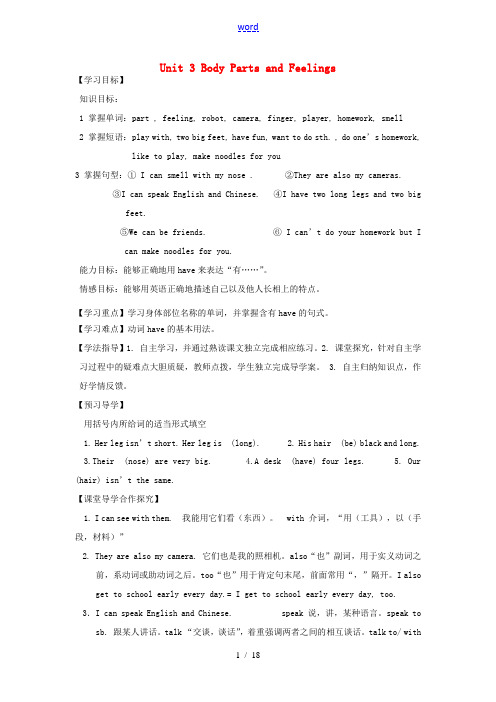
Unit 3 Body Parts and Feelings【学习目标】知识目标:1 掌握单词:part , feeling, robot, camera, finger, player, homework, smell2 掌握短语:play with, two big feet, have fun, want to do sth. , do one’s homework,like to play, make noodles for you3 掌握句型:① I can smell with my nose . ②They are also my cameras.③I can speak English and Chinese. ④I have two long legs and two bigfeet.⑤We can be friends. ⑥I can’t do your homework but Ican make noodles for you.能力目标:能够正确地用have来表达“有……”。
情感目标:能够用英语正确地描述自己以及他人长相上的特点。
【学习重点】学习身体部位名称的单词,并掌握含有have的句式。
【学习难点】动词have的基本用法。
【学法指导】1. 自主学习,并通过熟读课文独立完成相应练习。
2. 课堂探究,针对自主学习过程中的疑难点大胆质疑,教师点拨,学生独立完成导学案。
3. 自主归纳知识点,作好学情反馈。
【预习导学】用括号内所给词的适当形式填空1. Her leg isn’t short. Her leg is (long).2. His hair (be) black and long.3.Their (nose) are very big.4.A desk (have) four legs.5. Our (hair) isn’t the same.【课堂导学合作探究】1. I can see with them. 我能用它们看(东西)。
七年级英语上册 Unit 3 Body Parts and Feelings基础知识过关三讲义 冀教版.ppt
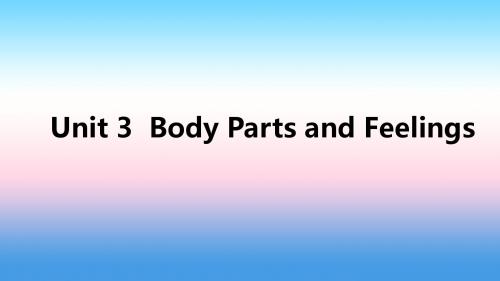
单元基础知识过关三
11.有点儿;稍微______a_b_it_/l_it_tl_e ____ 12.靠着……站____s_ta_n_d_a_g_a_in_s_t ___ 13.胃疼___h_av_e_a_s_t_om__a_ch_a_c_h_e 14.多高______h_ow__ta_l_l _____ 15.看起来像_____lo_o_k_l_ik_e______
单元基础知识过关三
5.感冒 ____c_a_tc_h_a_c_o_ld_____ 6.待在家里 ____st_a_y_h_om__e______ 7.休息一下 ___h_av_e_/t_a_k_e_a_r_es_t___ 8.看起来不同 ___l_oo_k_d_i_ff_e_re_n_t____ 9.挥手___w__av_e_o_n_e_'s_h_a_n_d__ 10.火冒三丈______s_e_e_r_ed______
单元基础知识过关三
5.笑(v.) ___l_a_ug_h___ 6.停留;留下;待一段时间(v.) ___st_a_y__ 7.休息(n.&v.) ____r_es_t___ 8.部分(n.) ____p_ar_t___ 9.感觉;情感(n.) ___f_ee_li_n_g__ 10.机器人(n.) ___r_o_bo_t___ 11.照相机(n.) ___ca_m__er_a__
单元基础知识过关三
9.她十二岁了。 She is ___t_w_el_v_e_ ____y_e_ar_s_ ____ol_d___. 10.我留着黑色的短发。 I have ___sh_o_r_t__ ___b_la_c_k__ hair. 11.别难过。 Don't ____be____ __s_a_d____.
七年级英语 Unit 3 Body Parts and Feelings语法聚焦三
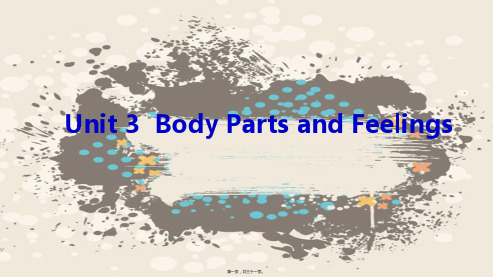
单元语法(yǔfǎ)聚焦三
(5)以f 或fe 结尾的名词,一般将f或fe改为ves。例如: knife→knives(小刀); thief→thieves(贼); life→lives(生命); wife→wives(妻子) 注意:初中英语中,这类名词主要有wife(妻子),life(生命),knife(小刀), leaf(树叶),thief(贼),half(一半),self(自己),wolf(狼);它们的复数 形式均是将词尾的f或fe变为ves。另外,也有以f结尾的名词直接(zhíjiē) 加s构成复数(如:roof →roofs 屋顶),但这在初中英语中很少见。
Unit 3 Body Parts and Feelings
第一页,共三十一页。
Unit 3 Body Parts and Feelings
单元语法聚焦三
名词复数&实义动词(dòngcí)have的用法
第二页,共三十一页。
单元(dānyuán)语法聚焦三
一、名词复数
教材(jiàocái)典句
1. I have two big eyes. 我有一双大眼睛。 2. I don't have ears but I can hear you.
6. leaf ___le_av_e_s__
7.glass ___gl_a_ss_es__
8. dish ___d_is_h_e_s _
第二十页,共三十一页。
单元(dānyuán)语法聚焦三
Ⅱ.用have或has填空(tiánkòng) 1.I ____h_av_e__ many good friends. 2.Tom ____h_a_s__ big blue eyes. 3.My classroom _____h_a_s _ eight windows. 4.The boy in blue pants ______h_a_s long legs. 5.Jenny and Danny____h_av_e__ two black pens.
秋七年级英语上Unit3BodyPartsandFeelingsLesson13BodyPart

A. talk
B. say
C. speak
D. tell
7. I really want to have a pet dog, ____A____ my mother
disagrees.
【中考·新疆】
A. but
B. and
C. or
D. so
8. We use our noses to ____B____.
习题链接 课后巩固•拓展延伸
26 to show feelings
答案呈现
27 He is small, cute and round.
28 In 2006.
29 NAO is one kind of them and it is our friend.
30 你仅仅需要与他交流。
一、根据汉语提示写单词, 并背记相应英语词汇 1. Look! A __r_o_b_o_t__(机器人) is working in a restaurant. 2. My father takes photos with his _c_a_m__er_a__(照相机). 3. How much ____h_o_m_e_w__o_r_k____(家庭作业) do you get?
课后巩固•拓展延伸
答案呈现
6C
11 reading/to read
7A
12 player
8B
13 mouths
9C 10 A
14 your 15 to go
习题链接
课后巩固•拓展延伸
16 Do; have 17 make; for 18 Can; tell 19 What colour 20 How many fingers
- 1、下载文档前请自行甄别文档内容的完整性,平台不提供额外的编辑、内容补充、找答案等附加服务。
- 2、"仅部分预览"的文档,不可在线预览部分如存在完整性等问题,可反馈申请退款(可完整预览的文档不适用该条件!)。
- 3、如文档侵犯您的权益,请联系客服反馈,我们会尽快为您处理(人工客服工作时间:9:00-18:30)。
Unit 3Ⅰ. 单项选择(15分)( )1. — Is it ________ leg?—No. It’s ________ arm.A. an; anB. a; aC. an; aD. a; an( )2. Jim is my good friend. ________ nose is big.A. HerB. HisC. SheD. He( )3. —We lost (输了) it. Do you feel ________?— Yes. But we will win (将会赢) next time.A. happyB. fineC. sadD. cold( )4. Wendy feels sick. She should (应该) go to ________ a doctor.A. seeB. lookC. meetD. reach( )5. Paul, stand ________ your feet.A. inB. outC. toD. on( ) 6. Please open your ________ and look at the blackboard.A. eyesB. mouthC. earsD. nose( ) 7. Look ________ the girl. She has long hair.A. toB. likeC. atD. for( ) 8. Stand ________ your feet, please.A. onB. upC. atD. in( ) 9. Danny________ a headache.A. do not haveB. do not hasC. does not haveD. does not has( ) 10. — , Jenny?—I cut my finger.A. What’s the wrongB. What matterC. What’s the matterD. What wrong( )11. — ________ are you, Bella?—I’m 1.5 metres tall.A. How tallB. How many metresC. HowD. How long( )12. — Your eyes are beautiful!— ________.A. You are rightB. No, thanksC. Yes, they are niceD. Thank you( )13. — ________?— No, he is sick.A. Is Bill okayB. How are youC. What about the boyD. Are you tall( )14. — ________?— My arms hurt.A. What’s the matterB. What are theyC. Do you feel tiredD. How is the boy( )15. — ________?— She is pretty. Her hair is blond.A. Is she prettyB. What colour does she likeC. Is her hair blondD. What does she look likeⅡ. 完形填空(10分)I’m Brain. I 16 a good friend. His name is Jack. He 17 from Canada. He likes brown best(最). What 18 Jack look like? He 19 cool. His eyes are big and blue. He has short, 20 hair, and it’s his favourite colour. Ja ck is 21 . He is just 1.4 metres tall. Jack likes to tell 22 stories (故事) and I like him (他) very much. But I feel 23 today, because (因为) he feels 24 .I take him to 25 a doctor.( )16. A. have B. am C. want D. stay( )17. A. am B. is C. are D. /( )18. A. is B. does C. are D. do( )19. A. likes B. meets C. feels D. looks( )20. A. black B. red C. brown D. yellow根据表格内容,判断句子的正(T)误(F)。
( )26. David has short, black hair.( )27. Mary’s eyes are brown.( )28. Jack’s hair is black.( )29. Mary and Jack both (两者都) have a big nose.( )30. David and Jack are the same (相同的) height.BHello! My name is Judy. I’m a student. I have three teachers. They are Miss Sun, Ms. Wood and Mr. Chen. And they teach (教) us English, Chinese and art (美术). Miss Sun is from Shanghai. She is my art teacher. She is pretty. She is 1.65 metres tall. Ms. Wood is from Canada. She is 1.75 metres tall. She has short, brown hair. Her eyes are small and blue. Mr. Chen is my Chinese teacher. He is from China. He is wearing a white shirt and a pair of blue pants. He has small eyes. They are good teachers. I like them.根据短文内容,选择最佳答案。
( )31. Miss Sun is ________ tall.A. 1.6 metresB. 1.65 metresC. 1.7 metresD. 1.75 metres( )32. ________ is an English teacher.A. JudyB. Miss SunC. Ms. WoodD. Mr. Chen( )33. Ms. Wood has ________ hair.A. short, brownB. short, blackC. long, brownD. long, black( )34. Judy’s Chinese teacher is wearing ________.A. a pink dressB. a pair of blue shortsC. a white shirt and a pair of blue pantsD. a white sweater and a pair of pants( )35. ________ are from China.A. Miss Sun and Mr. ChenB. Ms. Wood and Miss SunC. Mr. Chen and Ms. WoodD. The three teachersⅣ. 词语运用(10分)A.根据句意及汉语提示写出正确的单词。
(5分)36. Is Mr. Brown a __________ (医生)?37. Do you have a __________ (头疼)?38. My whole (整个的) __________ (身体) hurts.39. Tommy likes __________ (不同的) colours.40. Please open (张开) your __________ (嘴), Lisa.B.用所给单词的适当形式填空。
(5分)41. Look at her __________ (eye)! They’re green.42. What colour __________ (be) your hair?43. Her left ear __________ (hurt).44. We have two __________ (foot).45. Mr. Smith __________ (have) a big nose.Ⅴ. 情景交际(10分)根据对话内容,从方框中选择适当的句子填入相应的空白处。
Zhou Jie: Hello, Liu Hong. (46)__________Liu Hong: I feel happy. (47)__________ She is from Canada. Zhou Jie: Does she look the same as us?Liu Hong: No, she doesn’t.Zhou Jie: Really? (48)__________Liu Hong: Her hair is long and blond.Zhou Jie: What colour are her eyes?Liu Hong: Blue. She has blue eyes.Zhou Jie: (49)__________Liu Hong: She is 1.58 meters tall.Zhou Jie: (50)__________Liu Hong: Her name is Helen.Zhou Jie: Oh, I know. She is a good student in our school.A. What colour is her hair?B. How tall is she?C. I have a new friend.D. What’s her name?E. How do you feel today?Ⅵ. 根据汉语意思完成下列句子,每空一词。
(10分)51. 他割伤了他的左胳膊。
He cuts his __________ __________.52. 她的钥匙在右手里。
